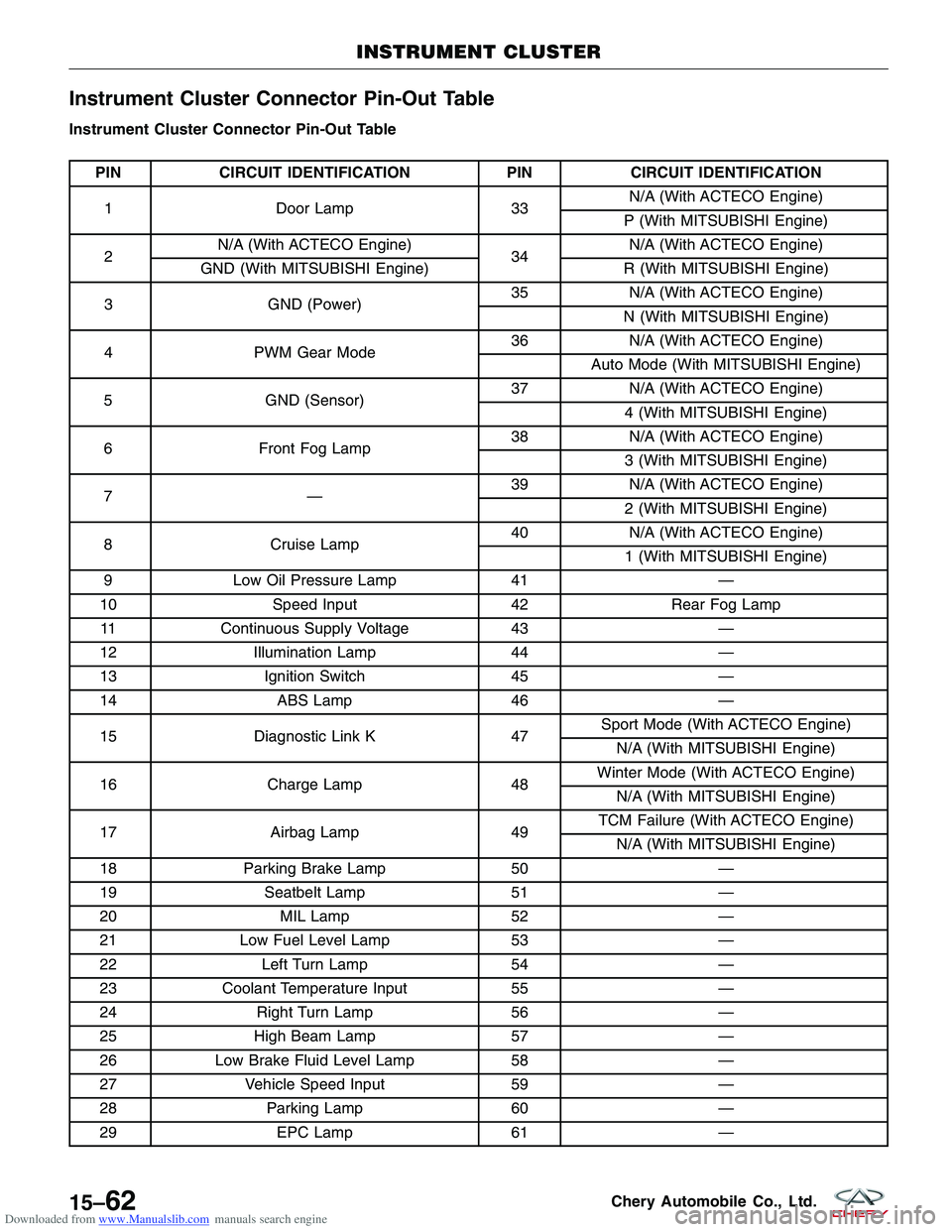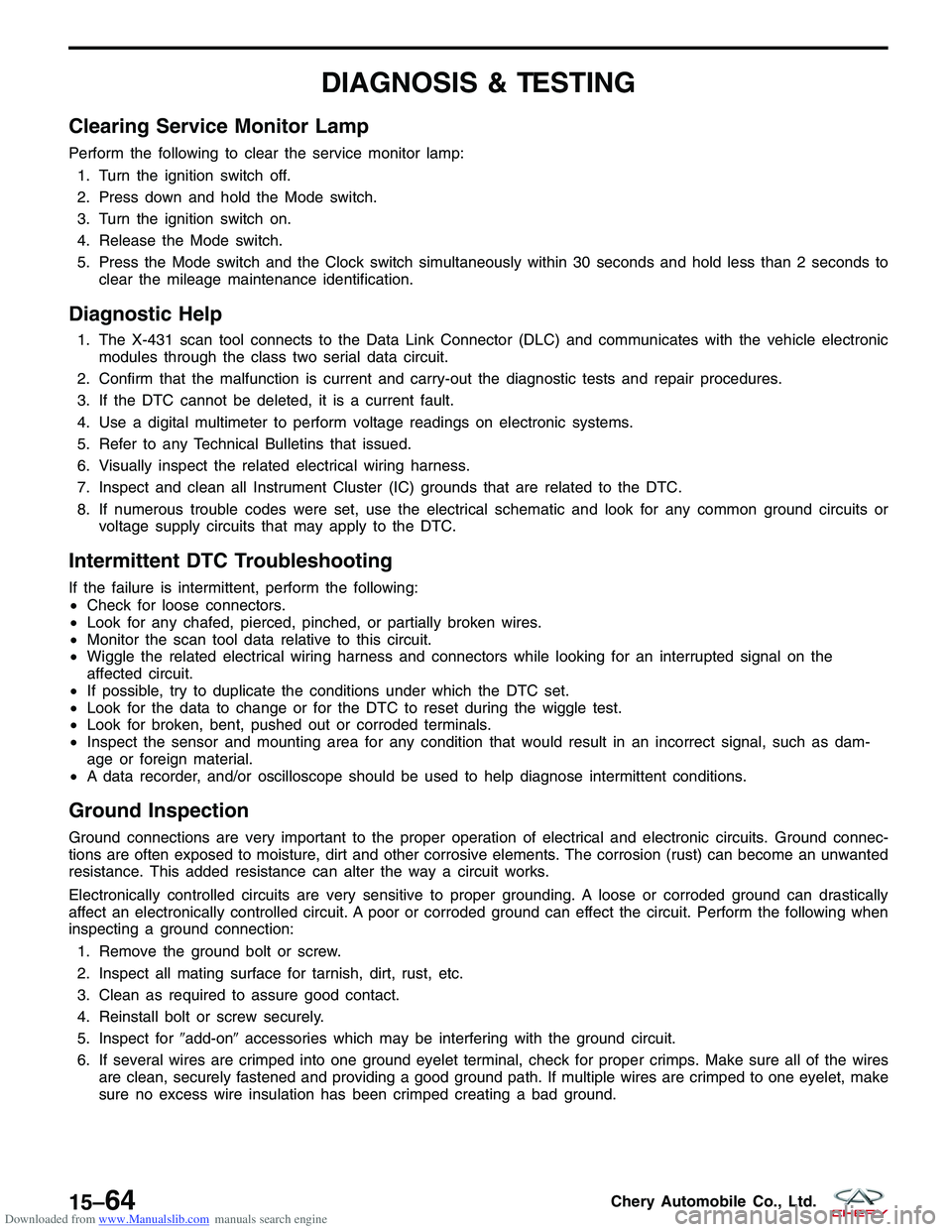Page 1581 of 1903
Downloaded from www.Manualslib.com manuals search engine ON-VEHICLE SERVICE
Front Seat Belt and Pre-Tensioner
Removal & Installation
1. Turn the ignition off.
2. Disconnect the negative battery cable.
3. Remove the seat belt upper mounting bolt (1).
4. Remove the seat belt lower mounting bolt (1).
5. Remove the B-pillar lower trim panel.
LTSM150077
LTSM150076
14–52Chery Automobile Co., Ltd.
Page 1582 of 1903
Downloaded from www.Manualslib.com manuals search engine 6. Remove the front seat belt pre-tensioner retainingbolt (1) and screw (2).
(Tighten: Front seat belt retaining bolt to 50 N·m)
7. Remove the front seat belt and pre-tensioner.
8. Installation is in the reverse order of removal.
Seat Belt Slider Track
Removal & Installation
1. Turn the ignition off.
2. Remove the seat belt upper mounting bolt (1).
3. Remove the B-pillar upper trim panel.
ON-VEHICLE SERVICE
LTSM140003
LTSM150077
14
14–53Chery Automobile Co., Ltd.
Page 1583 of 1903
Downloaded from www.Manualslib.com manuals search engine 4. Remove the two bolts (1) and then remove theseat belt slider track.
(Tighten: Adjustable shoulder belt anchor bolts to
50 N·m)
5. Installation is in the reverse order of the removal.
Rear Seat Belt and Pre-Tensioner
Removal & Installation
1. Turn the ignition off.
2. Remove the rear seat belt mounting bolts (1). (Tighten: Rear seat belt mounting bolts to 50 N·m)
3. Remove the C-pillar (See C-pillar Trim Panel Remove & Installation in Section 15 Body & Acces-
sories).
ON-VEHICLE SERVICE
BESM140006
LTSM140005
14–54Chery Automobile Co., Ltd.
Page 1588 of 1903
Downloaded from www.Manualslib.com manuals search engine AUDIO SYSTEM
Description
The audio system consists of the following components:
•Audio Unit
• Front Speakers
• Front Tweeters
• Rear Speakers
• Window Antenna (audio)
The audio system is standard factory-installed equipment. The system uses an ignition switched source of battery
current so that the system will operate when the ignition switch is in the LOCK/ACC/ON positions. The system will
also operate in the OFF position for one hour.
Operation
With the audio system on, radio signals are received by the window antenna, the audio unit then sends audio signals
to front speakers and rear speakers.
15–4Chery Automobile Co., Ltd.
Page 1613 of 1903
Downloaded from www.Manualslib.com manuals search engine DOOR LOCKS
Description
The power door locks allow the doors to be locked or unlocked electronically. The power door lock switch is located
on the front door trim panel. The power door locks can also be operated by the Remote Keyless Entry (RKE) trans-
mitter.
Operation
The power lock system receives non-switched battery current, so that the power locks remain operational, regardless
of the ignition switch position. The power lock system is controlled by BCM.
15
15–29Chery Automobile Co., Ltd.
Page 1619 of 1903
Downloaded from www.Manualslib.com manuals search engine Door Lock Switch
Removal & Installation
1. Turn the ignition switch off.
2. Remove the power window and door lock/unlockswitch bezel mounting screw (1).
3. Using a trim stick, pry out the power window and door lock/unlock switch assembly from the front door.
4. Disconnect the power window and door lock/unlock switch electrical connectors.
5. Remove the power window and door lock/unlock switch retaining screws to remove the power window and door lock/unlock switch.
6. Installation is in the reverse order of removal
Door Lock Assembly
Removal & Installation
NOTE :
The passenger door is shown, all other doors are similar.
1. Disconnect the negative battery cable.
2. Turn the ignition switch off.
3. Using a small trim stick, remove the pull handle cover (1) from the pull handle (2).
DOOR LOCKS
LTSM150097
LTSM150139
15
15–35Chery Automobile Co., Ltd.
Page 1646 of 1903

Downloaded from www.Manualslib.com manuals search engine Instrument Cluster Connector Pin-Out Table
Instrument Cluster Connector Pin-Out Table
PINCIRCUIT IDENTIFICATION PINCIRCUIT IDENTIFICATION
1 Door Lamp 33N/A (With ACTECO Engine)
P (With MITSUBISHI Engine)
2 N/A (With ACTECO Engine)
34N/A (With ACTECO Engine)
GND (With MITSUBISHI Engine) R (With MITSUBISHI Engine)
3 GND (Power) 35
N/A (With ACTECO Engine)
N (With MITSUBISHI Engine)
4 PWM Gear Mode 36
N/A (With ACTECO Engine)
Auto Mode (With MITSUBISHI Engine)
5 GND (Sensor) 37
N/A (With ACTECO Engine)
4 (With MITSUBISHI Engine)
6 Front Fog Lamp 38
N/A (With ACTECO Engine)
3 (With MITSUBISHI Engine)
7— 39
N/A (With ACTECO Engine)
2 (With MITSUBISHI Engine)
8 Cruise Lamp 40
N/A (With ACTECO Engine)
1 (With MITSUBISHI Engine)
9 Low Oil Pressure Lamp 41—
10 Speed Input 42Rear Fog Lamp
11 Continuous Supply Voltage 43—
12 Illumination Lamp 44—
13 Ignition Switch 45—
14 ABS Lamp 46—
15 Diagnostic Link K 47Sport Mode (With ACTECO Engine)
N/A (With MITSUBISHI Engine)
16 Charge Lamp 48Winter Mode (With ACTECO Engine)
N/A (With MITSUBISHI Engine)
17 Airbag Lamp 49TCM Failure (With ACTECO Engine)
N/A (With MITSUBISHI Engine)
18 Parking Brake Lamp 50—
19 Seatbelt Lamp 51—
20 MIL Lamp 52—
21 Low Fuel Level Lamp 53—
22 Left Turn Lamp 54—
23 Coolant Temperature Input 55—
24 Right Turn Lamp 56—
25 High Beam Lamp 57—
26 Low Brake Fluid Level Lamp 58—
27 Vehicle Speed Input 59—
28 Parking Lamp 60—
29 EPC Lamp 61—
INSTRUMENT CLUSTER
15–62Chery Automobile Co., Ltd.
Page 1648 of 1903

Downloaded from www.Manualslib.com manuals search engine DIAGNOSIS & TESTING
Clearing Service Monitor Lamp
Perform the following to clear the service monitor lamp:1. Turn the ignition switch off.
2. Press down and hold the Mode switch.
3. Turn the ignition switch on.
4. Release the Mode switch.
5. Press the Mode switch and the Clock switch simultaneously within 30 seconds and hold less than 2 seconds to clear the mileage maintenance identification.
Diagnostic Help
1. The X-431 scan tool connects to the Data Link Connector (DLC) and communicates with the vehicle electronicmodules through the class two serial data circuit.
2. Confirm that the malfunction is current and carry-out the diagnostic tests and repair procedures.
3. If the DTC cannot be deleted, it is a current fault.
4. Use a digital multimeter to perform voltage readings on electronic systems.
5. Refer to any Technical Bulletins that issued.
6. Visually inspect the related electrical wiring harness.
7. Inspect and clean all Instrument Cluster (IC) grounds that are related to the DTC.
8. If numerous trouble codes were set, use the electrical schematic and look for any common ground circuits or voltage supply circuits that may apply to the DTC.
Intermittent DTC Troubleshooting
If the failure is intermittent, perform the following:
•Check for loose connectors.
• Look for any chafed, pierced, pinched, or partially broken wires.
• Monitor the scan tool data relative to this circuit.
• Wiggle the related electrical wiring harness and connectors while looking for an interrupted signal on the
affected circuit.
• If possible, try to duplicate the conditions under which the DTC set.
• Look for the data to change or for the DTC to reset during the wiggle test.
• Look for broken, bent, pushed out or corroded terminals.
• Inspect the sensor and mounting area for any condition that would result in an incorrect signal, such as dam-
age or foreign material.
• A data recorder, and/or oscilloscope should be used to help diagnose intermittent conditions.
Ground Inspection
Ground connections are very important to the proper operation of electrical and electronic circuits. Ground connec-
tions are often exposed to moisture, dirt and other corrosive elements. The corrosion (rust) can become an unwanted
resistance. This added resistance can alter the way a circuit works.
Electronically controlled circuits are very sensitive to proper grounding. A loose or corroded ground can drastically
affect an electronically controlled circuit. A poor or corroded ground can effect the circuit. Perform the following when
inspecting a ground connection:
1. Remove the ground bolt or screw.
2. Inspect all mating surface for tarnish, dirt, rust, etc.
3. Clean as required to assure good contact.
4. Reinstall bolt or screw securely.
5. Inspect for �add-on�accessories which may be interfering with the ground circuit.
6. If several wires are crimped into one ground eyelet terminal, check for proper crimps. Make sure all of the wires are clean, securely fastened and providing a good ground path. If multiple wires are crimped to one eyelet, make
sure no excess wire insulation has been crimped creating a bad ground.
15–64Chery Automobile Co., Ltd.